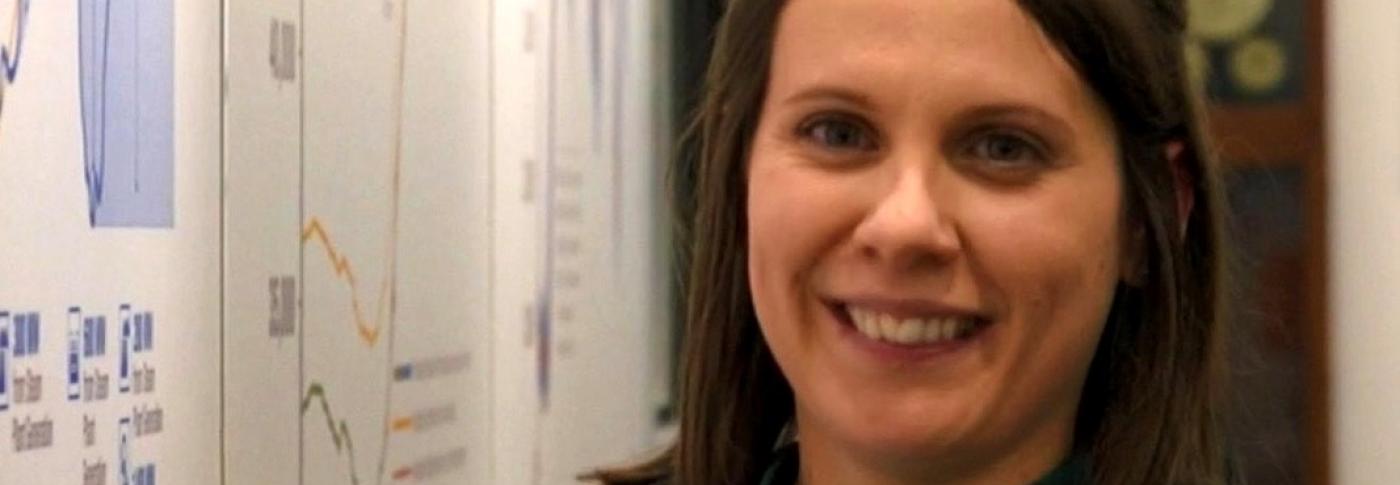
A day in the life of: Amy Weltevreden, Structuring & Optimisation Manager
26 Aug 2020 - 5 minute read
Our colleagues are at the heart of the ESO, working hard to operate a safe and reliable electricity system, whilst supporting the transition to a greener, and more efficient system for future generations.
Amy Weltevreden, Structuring & Optimisation Manager, gives an insight into her time at the ESO.
When did you join National Grid and how did you progress into your current role?
I joined eight years ago as part of the graduate development programme. My first placement was in the team that I’m now leading! I’ve come full circle.
I have a mathematics degree from the University of Warwick which led me to various analytical roles during my first few years with the company. I did three six-month placements across the company as part of the Graduate Development Programme and then my first post was a Strategy Analyst.
This involved identifying opportunities for the control room to balance more efficiently, for example reviewing our reserve and response policy or monitoring the performance of ancillary service providers.
Then I worked in business performance and improvement for three years, implementing lean ways of working into the organisation.
It was brilliant to work with all the teams across the ESO – planning, Future Energy Scenarios, customer connections, commercial operations - to identify ways to drive overall process efficiencies. I worked with leaders to implement a new operating model and deliver improvement projects to increase customer satisfaction and reduce the time needed to deliver customer needs.
I also really enjoyed the coaching side of the role - training leaders in coaching models and looking at what behaviours we wanted from leaders to help change the business philosophy. A lot of this has been embedded and I’ve seen a huge culture change for the better.
Having gained that experience, I returned to the core business to apply these skills as Commercial Lead for Power Potential, one of our NIC innovation projects trialling reactive power procurement from embedded generation in partnership with UKPN. That led me to my current role today, as Structuring & Optimisation Manager.
What do you do day to day?
My main focus is on within year operability to make sure the control room can secure the system at the lowest possible cost.
My team procure our reserve and response products and work with other teams to design and improve these markets as part of our ambitions for Competition Everywhere, and to operate a zero-carbon network by 2025. We’ve historically procured these products on a seasonal or monthly basis but are transitioning to day ahead procurement so it’s an exciting time.
We’re at the heart of the energy transition and need to design and develop new solutions as new technologies drive new system challenges.
For example, this summer we worked hard to design, develop and implement a new service (ODFM) to make sure the control room had access to additional downward flexibility. This is a need that was created as a result of the supressed demand driven by COVID-19 lockdown.
My team also work closely with our network planning colleagues to optimise constraint management and to secure our voltage requirements.
This is another area of transformation for ESO as our NOA pathfinders look to procure for our long-term operability needs. My team provides support into those projects to share our experiences of short-term operability.
How has the COVID-19 pandemic impacted your role?
This summer has been interesting! The low demand that came with the lockdown accelerated some of the operability challenges we’d been planning for and so that meant fast tracking our solutions too. In the case of ODFM, implementing time limited solutions to enable us to operate safely and economically this summer.
Everyone adapted brilliantly to working from home all the time. We’ve collaborated so well, and I’ve found it amazing that we can continue to do such complex problem solving without being in the same room.
We’re having lots of videos calls and in a good way it’s forced us to create more meeting structure and prepare a lot more for our time together as a team. It’s actually increasing productivity!
Before March this year I’d rarely taken any days to work from home in this role as the operational nature of the role meant it was valuable to be on site with the other operational teams.
The last five months have disproved that we need to be in the same place to be effective.
I think frequent working from home is the new normal, but I do miss the human interaction of being in the office and watercooler chats.
The biggest challenge for me has been how to switch off because there is such little separation between work and home. I almost miss my 30-minute commute! I hadn’t appreciated until now that it was my buffer zone between work and home. I’ve tried to replace the commute with exercise which is going OK!
What have you enjoyed doing most since lockdown ended?
It’s been nice to slow down. I’ve realised how much we used to rush around. I’ve enjoyed having the time to take pleasure in the simple things. I’ve never spent so much time in the garden!
I love to get away to explore a new country with my annual leave but this year it’s all about the staycation. I got married last June and we had planned a honeymoon to Costa Rica in April so that didn’t happen! But, we’ve made up for it with a trip to the New Forest which was fantastic and a lovely opportunity to relax.
